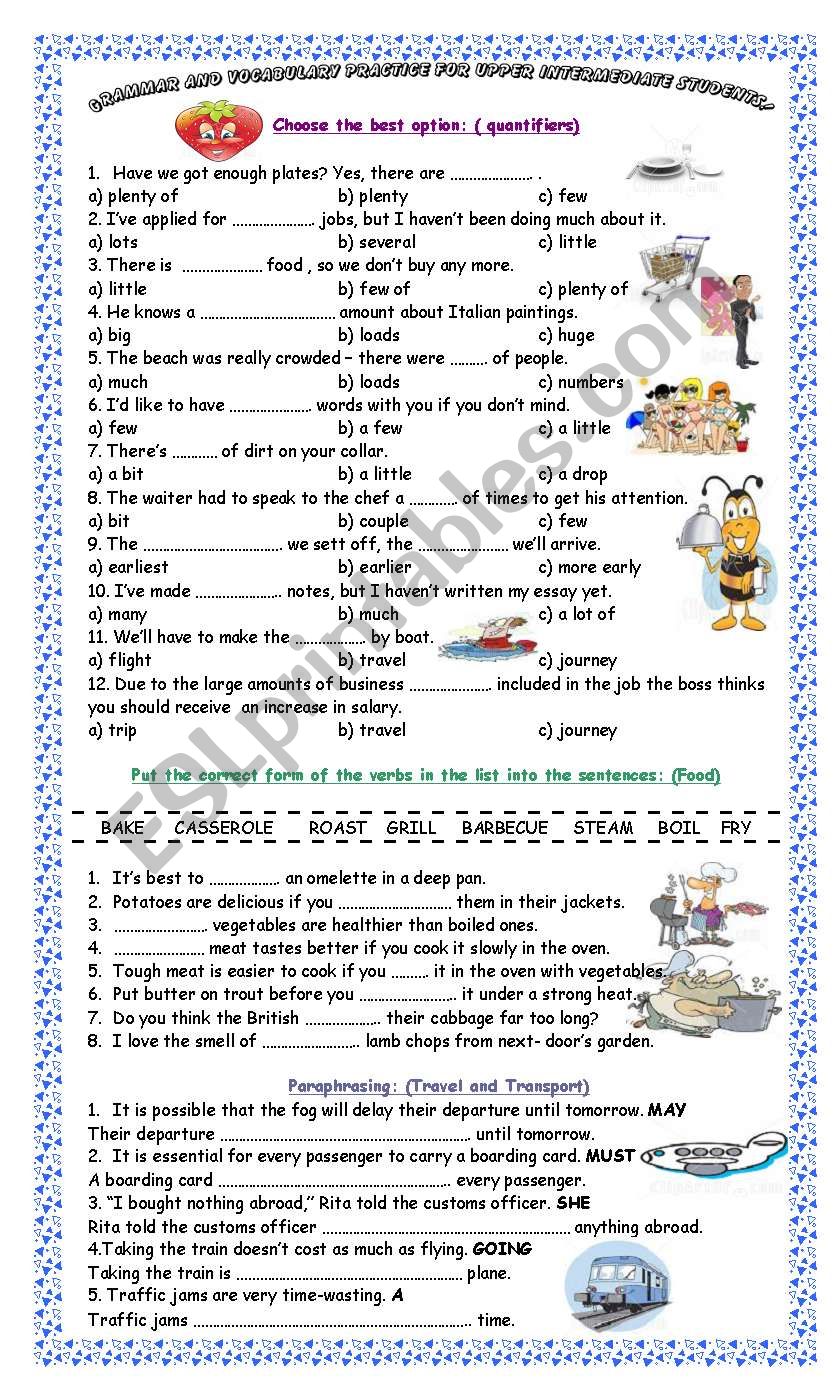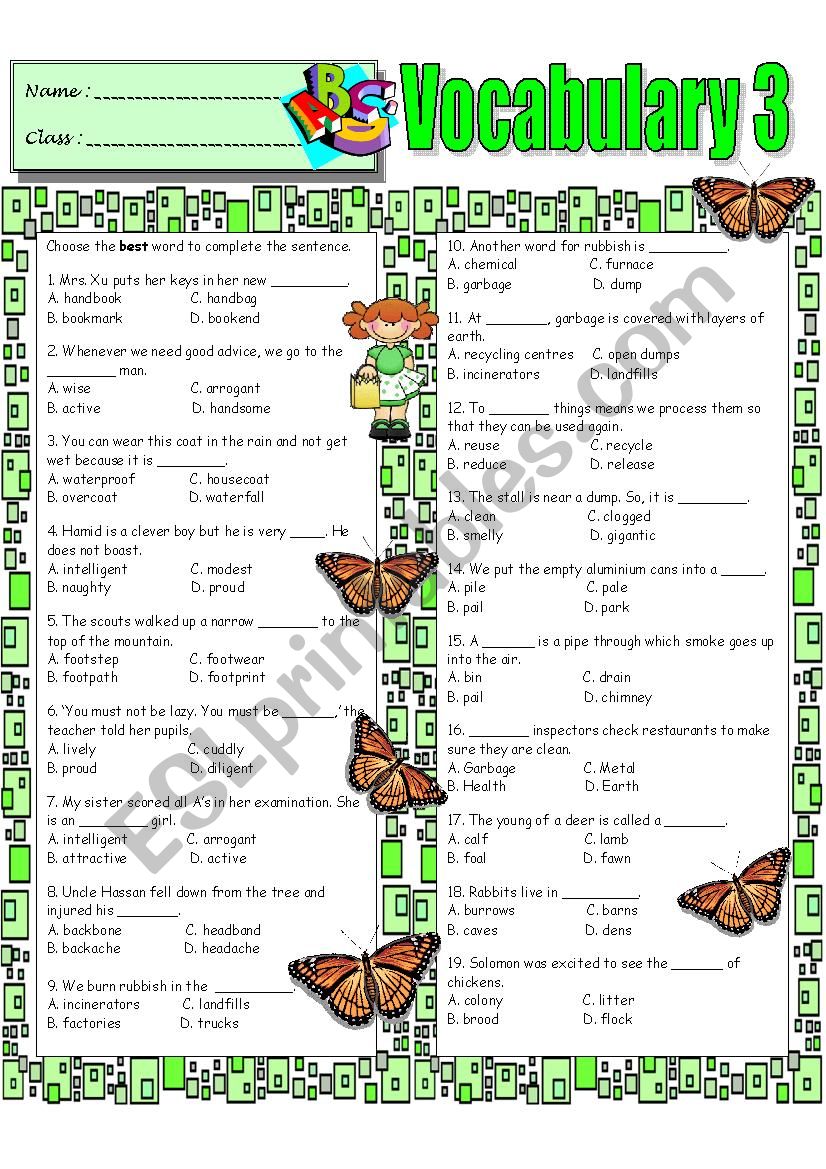
Unlocking Fluency: The Indispensable Role of Intermediate ESL Worksheets
The journey of learning English as a Second Language (ESL) is often depicted as a ladder, with each rung representing a stage of increasing proficiency. While the foundational steps of beginner grammar and vocabulary are crucial, the transition to the intermediate level marks a pivotal point. Learners at this stage have grasped the basics but often find themselves in a challenging "interlanguage" zone, capable of basic communication but struggling with nuance, complexity, and fluency. It is precisely at this juncture that Intermediate ESL worksheets emerge as an indispensable tool, providing the structured practice and targeted reinforcement necessary to bridge the gap from functional communication to confident, articulate expression.
This article will delve into the profound significance of Intermediate ESL worksheets, exploring their pedagogical value, the diverse types available, key considerations for their design and selection, and strategies for maximizing their impact in both classroom and self-study environments. By understanding their multifaceted role, educators and learners alike can leverage these resources to accelerate progress and unlock true English fluency.

Understanding the Intermediate Learner: A Unique Set of Challenges

Before delving into the specifics of worksheets, it’s vital to characterize the intermediate ESL learner. These individuals are no longer grappling with fundamental sentence structures or basic vocabulary. They can introduce themselves, discuss familiar topics, and navigate simple conversations. However, their challenges often lie in:

- Grammatical Accuracy: While they understand basic tenses, complex structures like perfect tenses, conditional sentences, passive voice, reported speech, and nuanced modal verbs often pose significant hurdles. Phrasal verbs and prepositions also remain notoriously difficult.
- Vocabulary Depth and Nuance: They possess a functional vocabulary, but lack the breadth of synonyms, antonyms, collocations, and idiomatic expressions needed for precise and natural communication. They might know "happy," but not "elated," "content," or "overjoyed."
- Fluency and Cohesion: Hesitation, awkward phrasing, and a lack of connective language (transition words, discourse markers) can disrupt the flow of their speech and writing.
- Listening Comprehension: Understanding natural, unscripted speech, different accents, and inferring meaning from context can be challenging.
- Reading Comprehension: Moving beyond literal understanding to inferring meaning, identifying main ideas in longer texts, and understanding complex arguments requires specific skills.
- Cultural and Pragmatic Understanding: Navigating politeness, sarcasm, humor, and appropriate language use in different social contexts is a major leap.



It is precisely these specific areas of difficulty that Intermediate ESL worksheets are designed to target, offering focused practice that reinforces learning and builds confidence.

The Pedagogical Power of Intermediate ESL Worksheets
Worksheets, when thoughtfully designed, are far more than mere busywork. They serve several critical pedagogical functions:

- Reinforcement and Practice: Language acquisition is not linear; it requires constant exposure and repetition. Worksheets provide a structured environment for learners to practice new grammatical structures, vocabulary, and concepts immediately after introduction, solidifying their understanding.
- Targeted Skill Development: Unlike general conversation, worksheets can isolate specific language points. A worksheet might focus solely on the present perfect continuous, ensuring concentrated practice until mastery.
- Active Engagement: Effective worksheets encourage active participation through fill-in-the-blanks, matching exercises, sentence completion, short answer questions, and creative writing prompts, moving beyond passive listening.
- Formative Assessment: Worksheets offer teachers a quick snapshot of their students’ understanding, highlighting areas where further instruction or different approaches might be needed. For self-learners, they provide immediate feedback on progress.
- Scaffolding Learning: Worksheets can progressively increase in difficulty, starting with simpler exercises and gradually introducing more complex tasks, mirroring the natural learning process.
- Building Confidence: Successfully completing a worksheet provides a sense of accomplishment, motivating learners to tackle more challenging aspects of the language.

Diverse Types of Intermediate ESL Worksheets and Their Benefits
The versatility of Intermediate ESL worksheets is one of their greatest strengths. They can be categorized by the skill or language area they target:
-
Grammar Worksheets:
- Focus: Complex verb tenses (past perfect, future perfect, conditional sentences), passive voice, reported speech, modals of deduction and speculation, phrasal verbs, prepositions of time/place/movement, relative clauses, articles (definite/indefinite).
- Benefits: Crucial for improving grammatical accuracy, reducing errors, and enabling learners to express more complex ideas precisely. Exercises might include sentence transformation, gap-fills, error correction, and choosing the correct structure in context.
-
Vocabulary Worksheets:
- Focus: Collocations (e.g., "make a decision" vs. "do a decision"), synonyms and antonyms, word families (e.g., "develop, development, developmental"), idiomatic expressions, topic-specific vocabulary (e.g., business English, environmental issues, travel).
- Benefits: Expands lexical range, allows for more nuanced expression, and makes speech and writing sound more natural. Activities include matching words to definitions, completing sentences with appropriate vocabulary, categorizing words, and using new words in sentences.
-
Reading Comprehension Worksheets:
- Focus: Longer texts (news articles, short stories, essays), identifying main ideas and supporting details, inferring meaning from context, understanding author’s tone or purpose, critical thinking questions, summarizing.
- Benefits: Develops reading speed and fluency, improves ability to extract information, enhances critical thinking skills, and exposes learners to diverse writing styles and content. Questions can range from multiple-choice to open-ended analytical prompts.
-
Listening Comprehension Worksheets:
- Focus: Audio clips featuring natural speed and accents (interviews, short talks, dialogues), identifying key information, understanding gist, inferring speaker’s intention, note-taking exercises.
- Benefits: Trains the ear to understand authentic speech, improves ability to process spoken information, and prepares learners for real-world listening situations. Exercises might involve filling in missing words from a transcript, answering questions about the audio, or summarizing the content.
-
Writing Prompts and Exercises:
- Focus: Paragraph construction, essay outlining, writing opinion pieces, formal and informal emails, summarizing texts, creative writing prompts, developing arguments, using cohesive devices.
- Benefits: Enhances ability to express ideas clearly and coherently in written form, improves sentence structure and paragraph organization, and builds confidence in producing various types of written output.
-
Speaking-Oriented Worksheets (for pair/group work):
- Focus: Discussion questions, debate topics, role-play scenarios (e.g., ordering food, complaining, negotiating), picture prompts for description and storytelling.
- Benefits: Although not "worksheets" in the traditional sense, these often come with structured prompts that facilitate communicative practice, improving fluency, pronunciation, and interactive skills in a controlled environment.
-
Integrated Skills Worksheets:
- Focus: Combining multiple skills, such as reading a text, answering comprehension questions, discussing the content, and then writing a response or summary.
- Benefits: Mimics real-world language use, where skills are rarely isolated, providing holistic practice and reinforcing connections between different language components.
Designing and Selecting High-Quality Intermediate ESL Worksheets
Not all worksheets are created equal. To be truly effective, Intermediate ESL worksheets should adhere to several key principles:
- Relevance and Authenticity: Content should be engaging and reflect real-world situations or topics of interest to intermediate learners. Authentic materials (adapted news articles, blog posts) are highly valuable.
- Clear Instructions: Learners should be able to understand what is expected of them without excessive guidance.
- Appropriate Challenge Level: Worksheets should be challenging enough to promote growth but not so difficult as to cause frustration. They should push learners slightly beyond their comfort zone (i+1 principle).
- Contextualization: Grammar and vocabulary should be presented and practiced in meaningful contexts, not in isolated sentences.
- Variety of Exercise Types: A mix of matching, gap-fills, multiple-choice, true/false, sentence completion, and open-ended questions keeps learners engaged.
- Scaffolding: Tasks can be broken down into smaller, manageable steps, gradually increasing in complexity.
- Answer Keys: For self-study, comprehensive answer keys are crucial for immediate feedback and self-correction. For classroom use, they aid teachers in quickly checking work.
- Visually Appealing: Clear layout, appropriate use of images, and legible fonts can significantly improve engagement.
Maximizing the Impact of Intermediate ESL Worksheets
Whether used in a classroom setting or for independent study, the way worksheets are utilized significantly impacts their effectiveness.
In the Classroom:
- Pre-activity Discussion: Activate prior knowledge and introduce relevant vocabulary before distributing the worksheet.
- Pair and Group Work: Encourage collaborative learning. Learners can discuss answers, explain reasoning, and correct each other’s mistakes.
- Teacher Guidance and Monitoring: Circulate to offer help, clarify instructions, and identify common errors.
- Post-activity Feedback and Discussion: Go over answers as a class, clarify misunderstandings, and encourage learners to explain their choices. Extend the activity with related speaking or writing tasks.
- Differentiation: Offer slightly varied worksheets for learners with different needs, or suggest optional extension activities for faster finishers.
For Self-Study:
- Consistency is Key: Encourage regular, focused practice rather than sporadic long sessions.
- Active Engagement: Don’t just fill in answers; try to understand why an answer is correct. Speak sentences aloud.
- Self-Correction: Use answer keys not just to check, but to understand mistakes. Why was the answer wrong? What rule was forgotten?
- Supplement with Other Resources: Worksheets are part of a larger learning ecosystem. Combine them with reading books, watching English media, and practicing speaking.
- Track Progress: Periodically review completed worksheets to see improvement and identify areas that still need work.
Conclusion
Intermediate ESL worksheets are far more than supplementary materials; they are foundational pillars in the intermediate learner’s journey towards advanced English proficiency. By providing structured, targeted, and engaging practice, they address the specific challenges of this critical stage, reinforcing grammar, expanding vocabulary, and honing comprehension skills across all modalities. From bridging grammatical gaps to fostering fluent expression, these meticulously crafted resources empower learners to solidify their understanding, build confidence, and ultimately unlock the full potential of their English language abilities. For educators and learners alike, embracing the power of well-designed Intermediate ESL worksheets is not just an option, but a strategic imperative for achieving true mastery.
